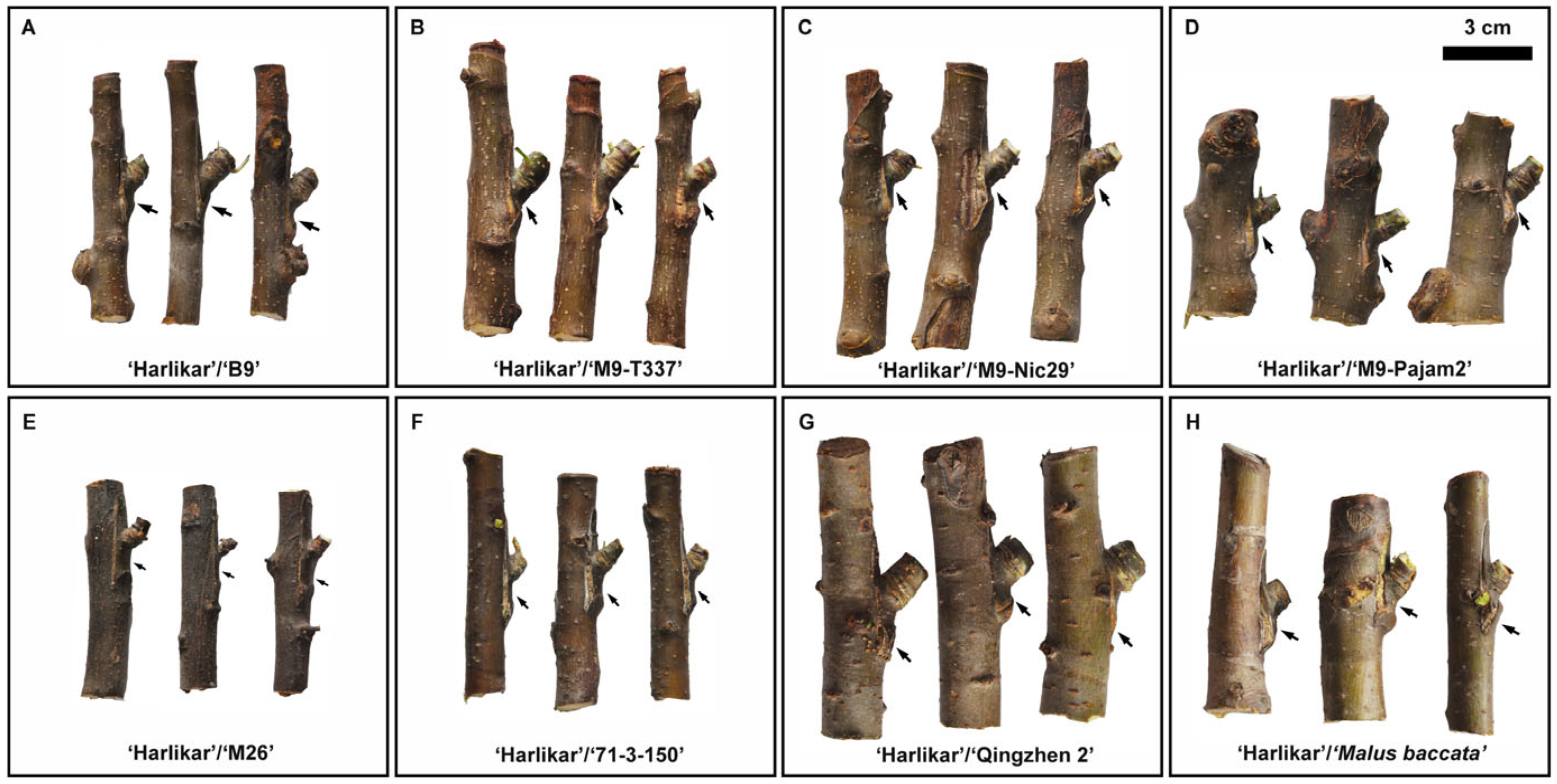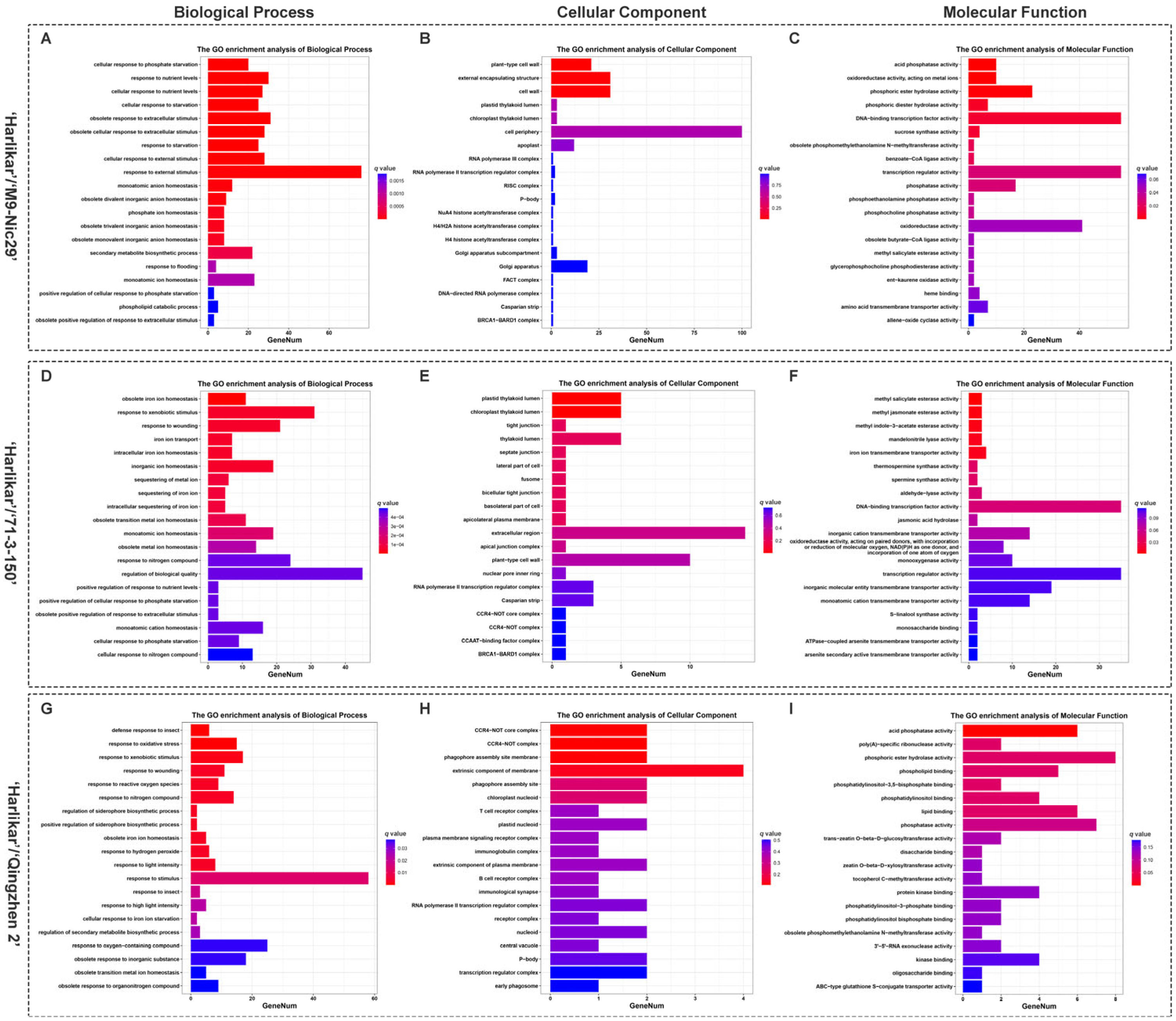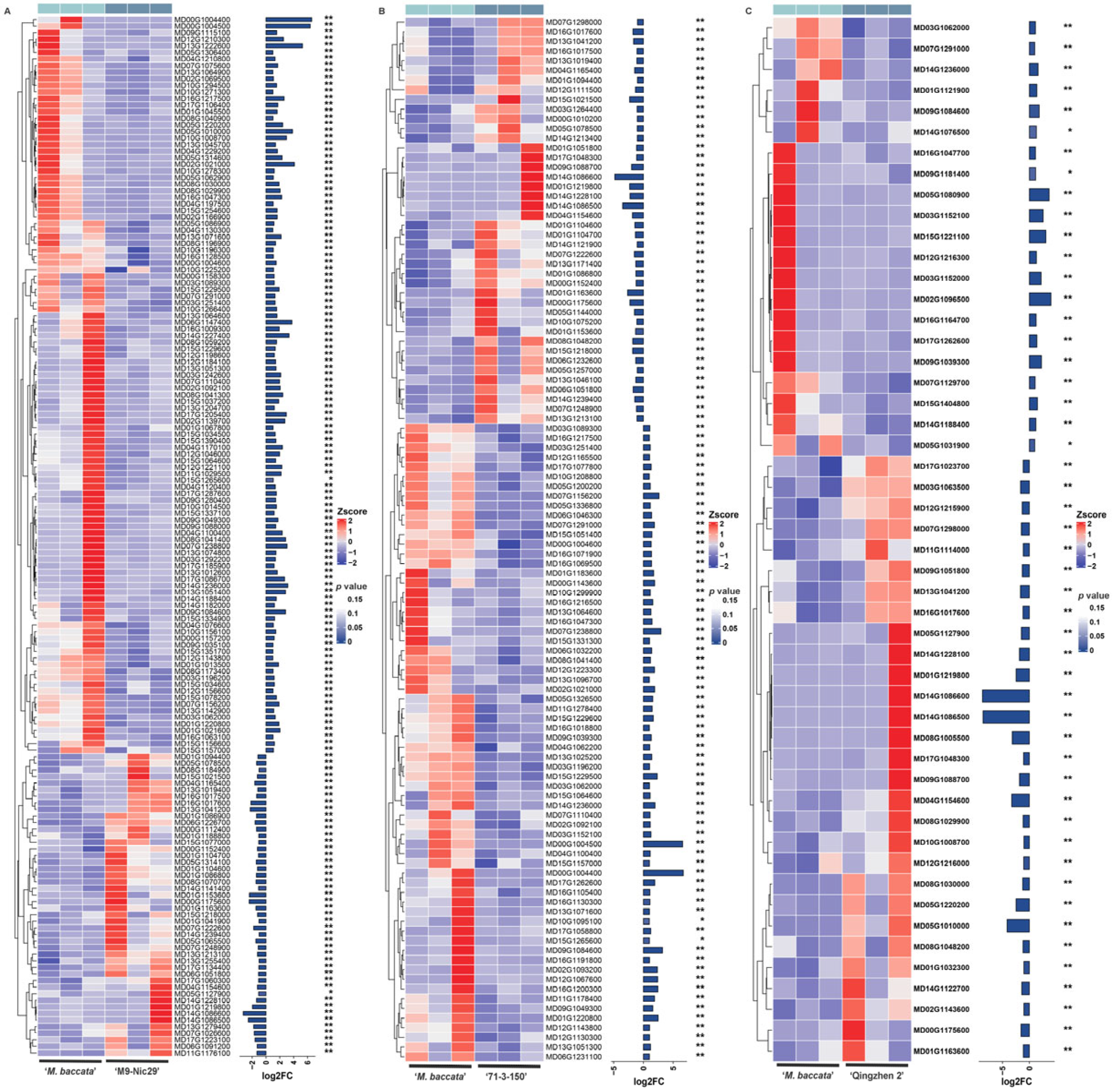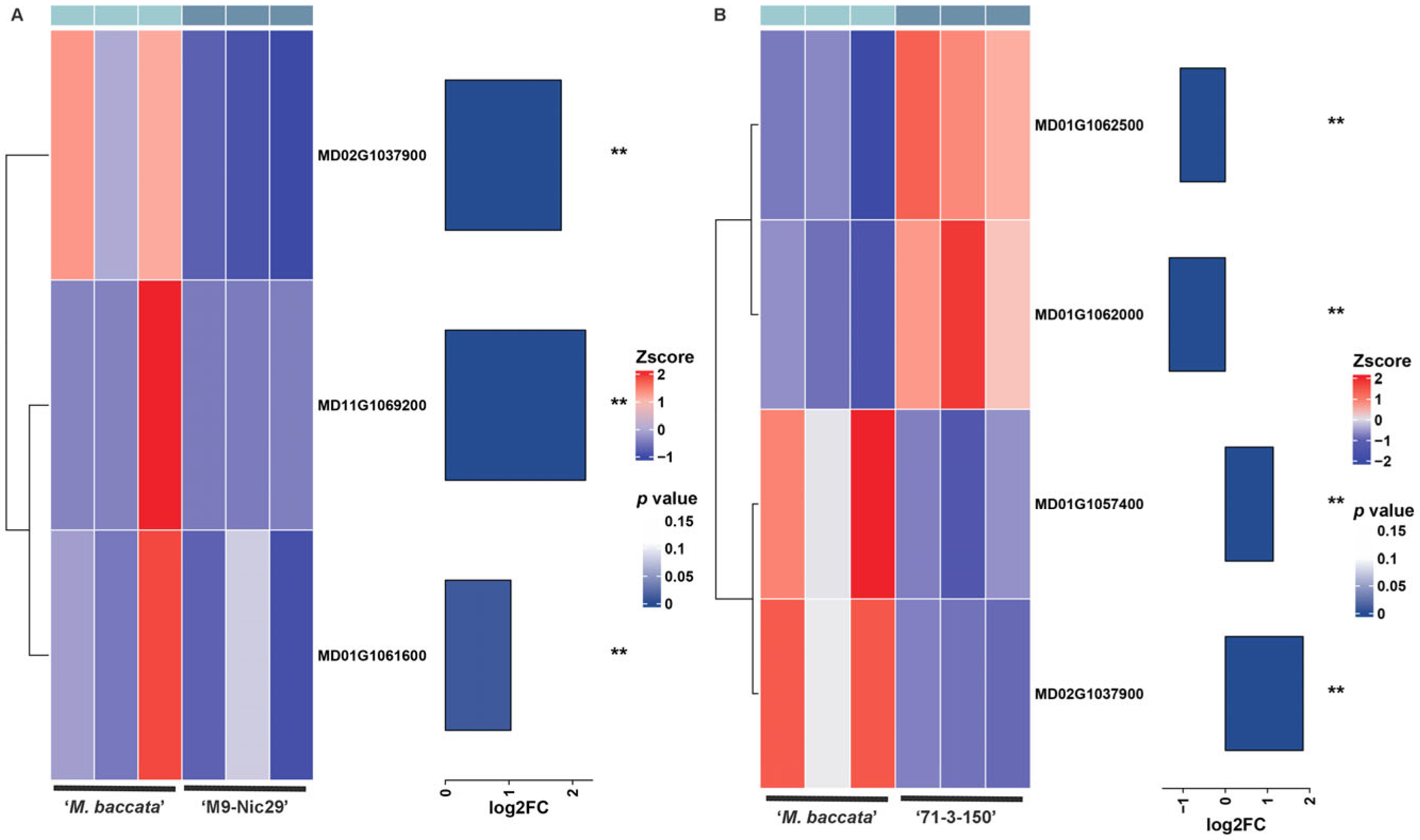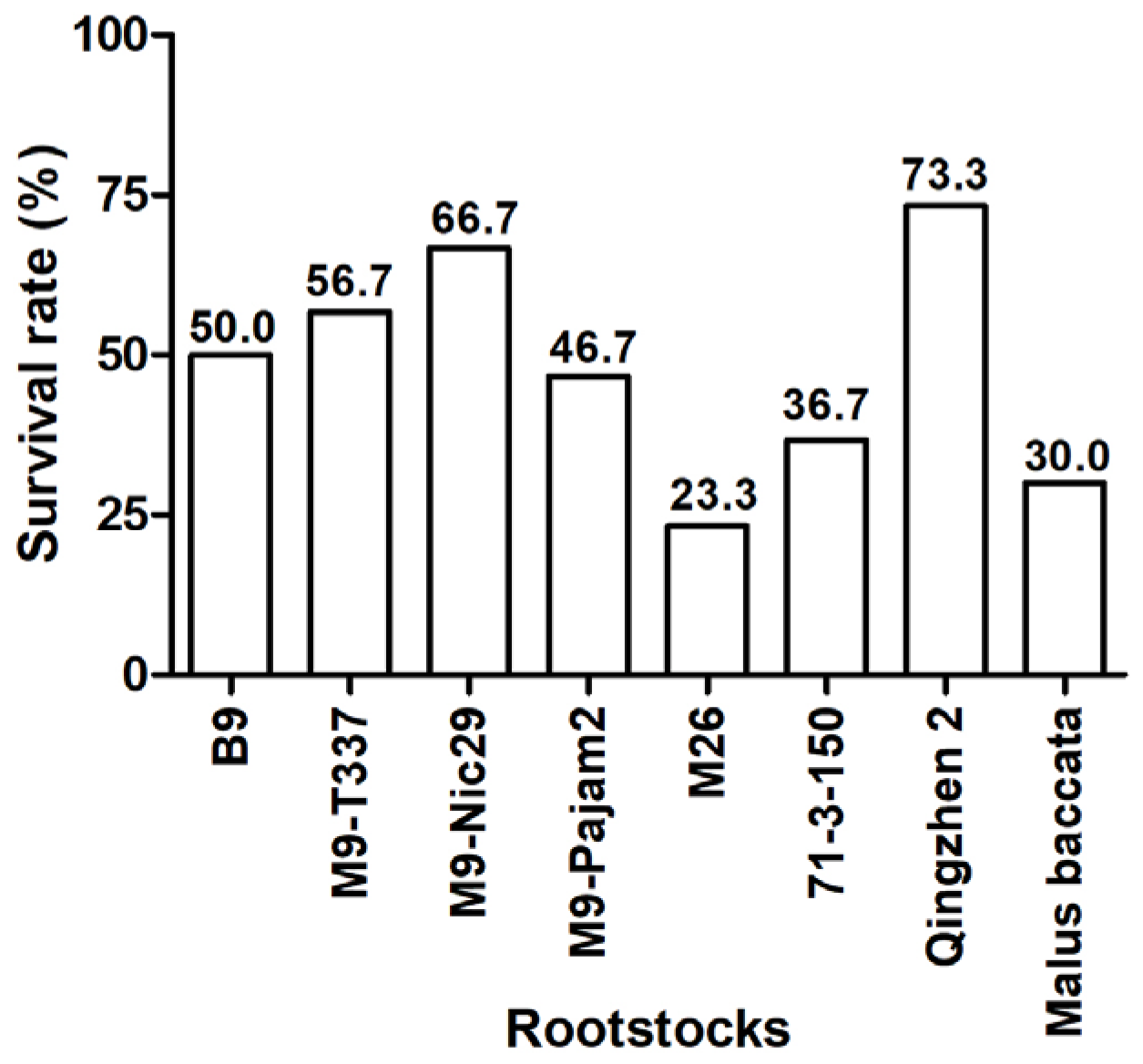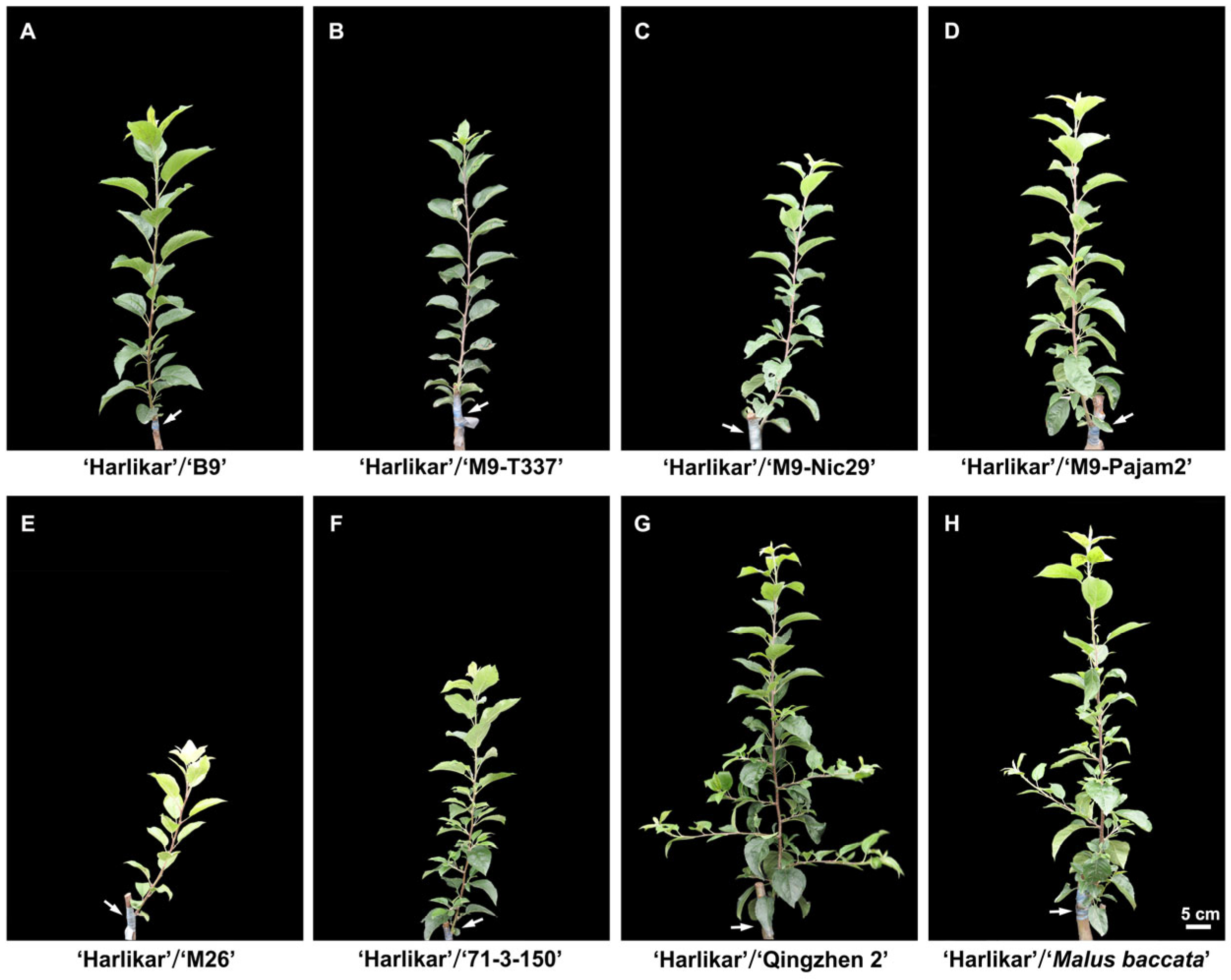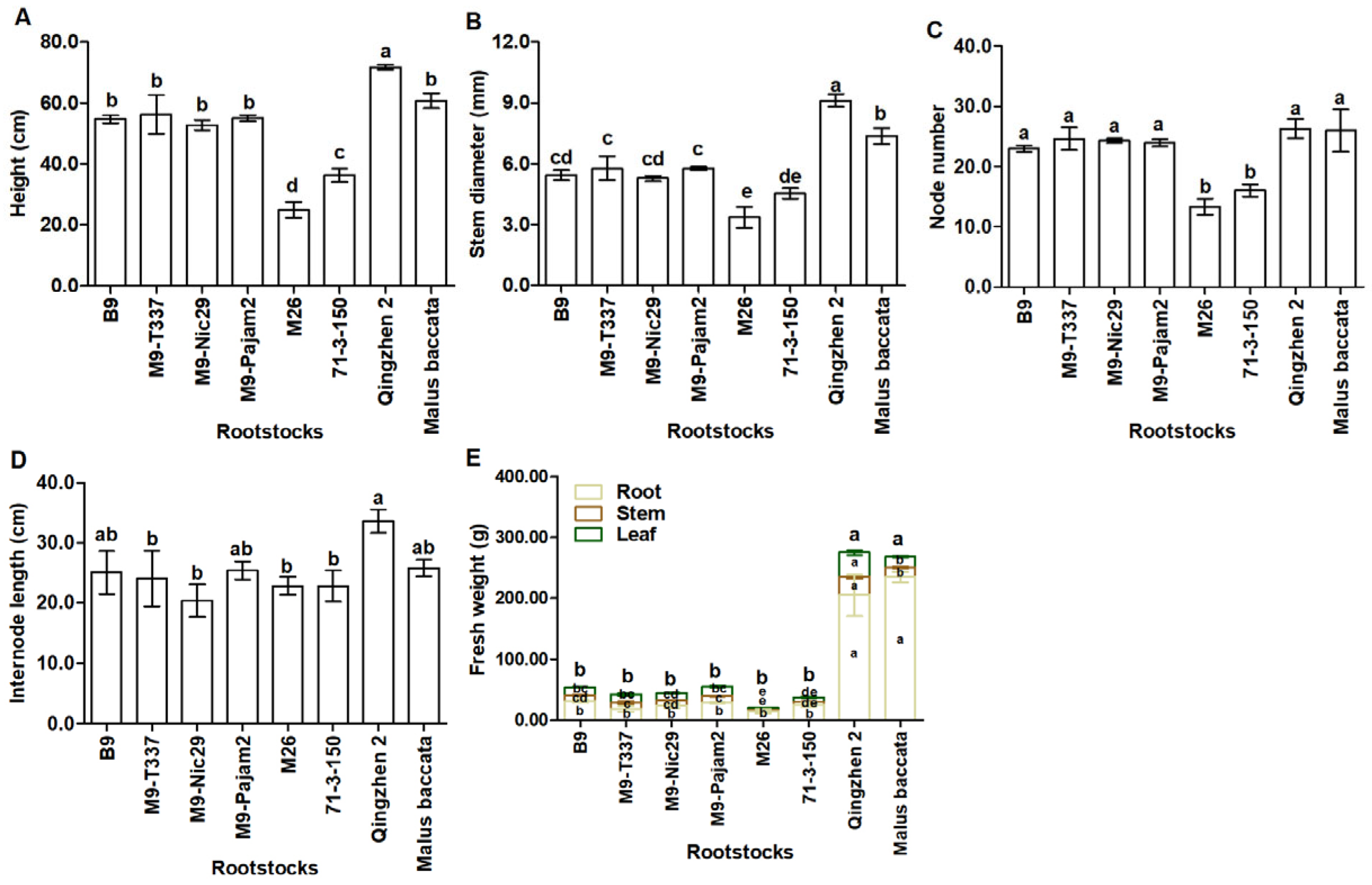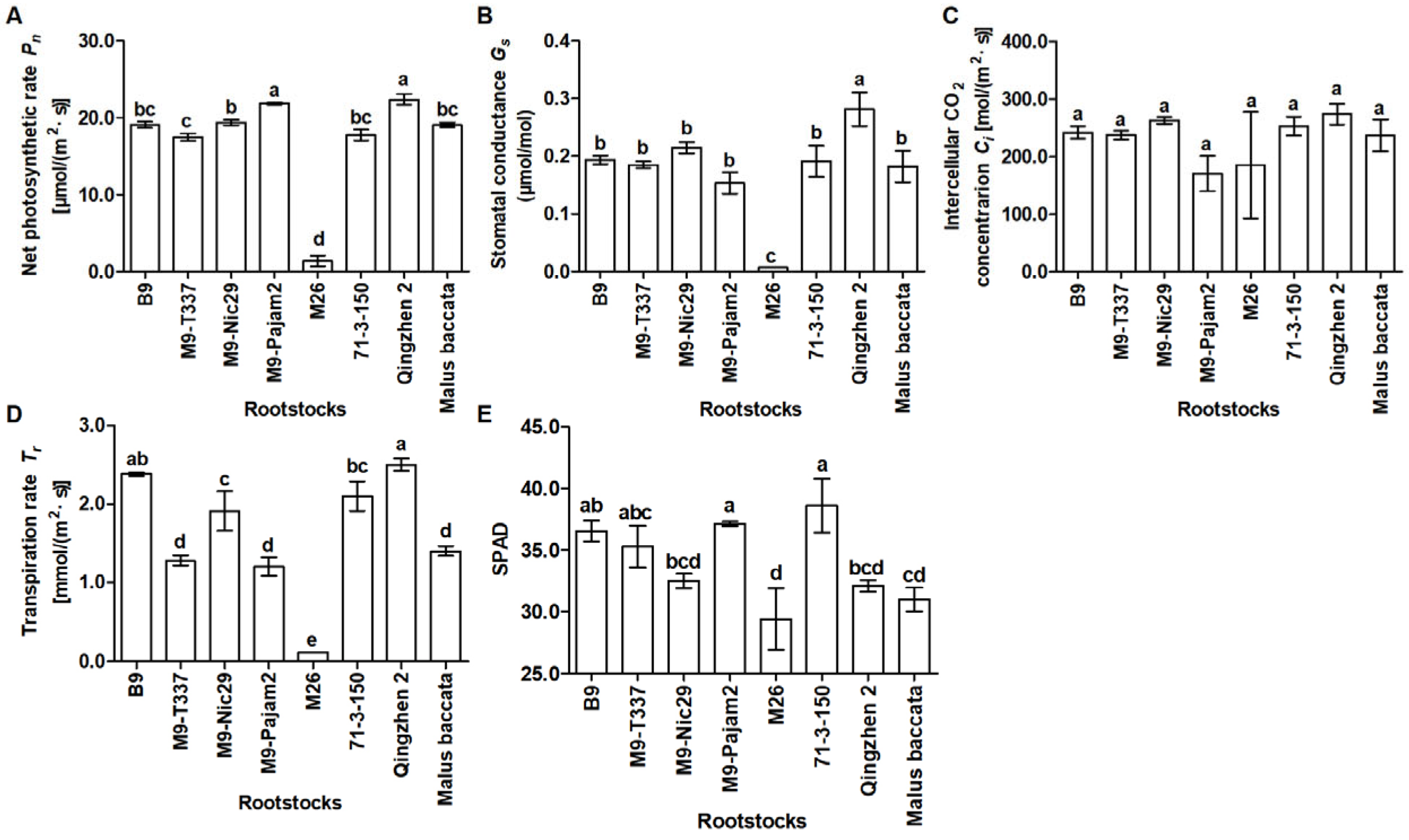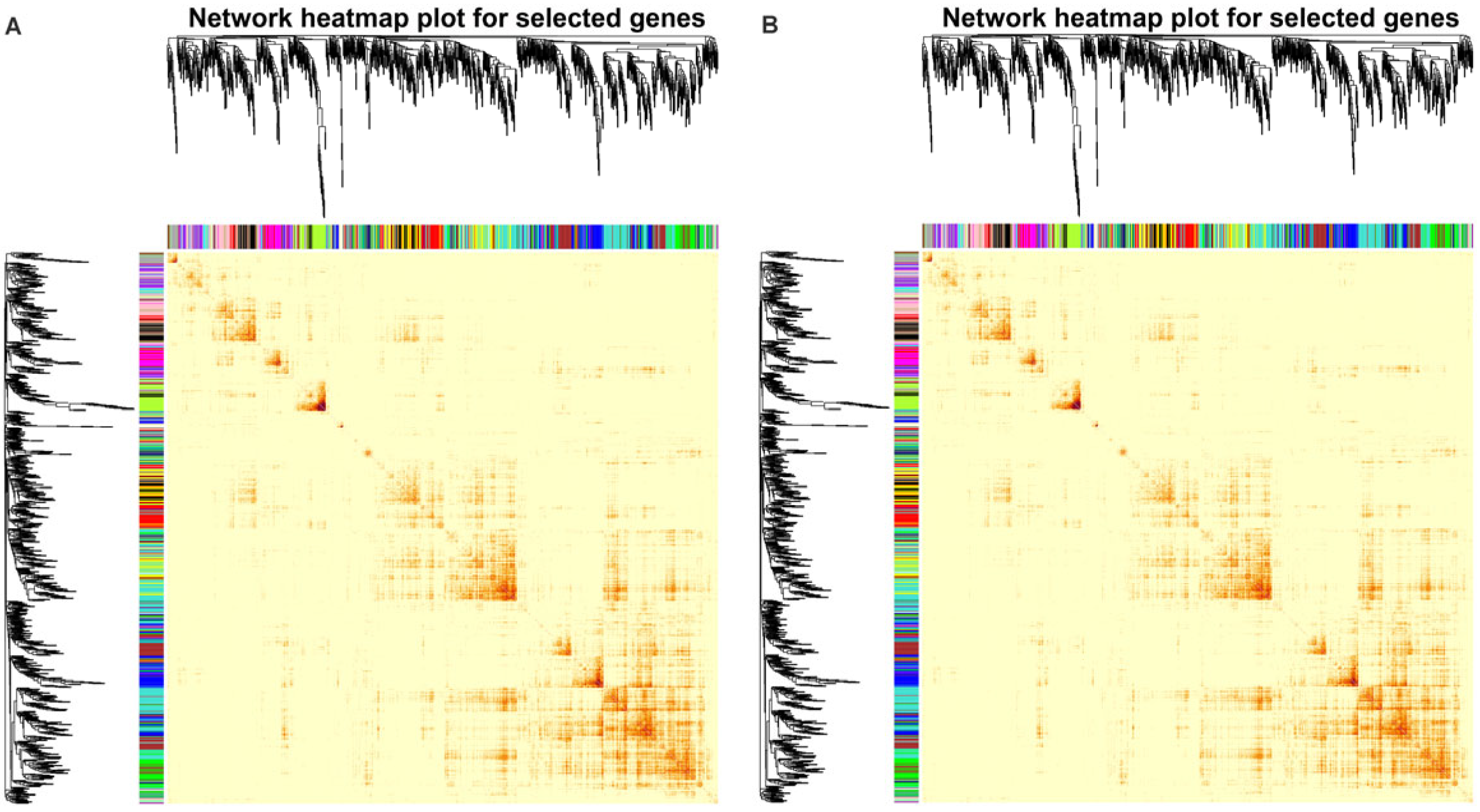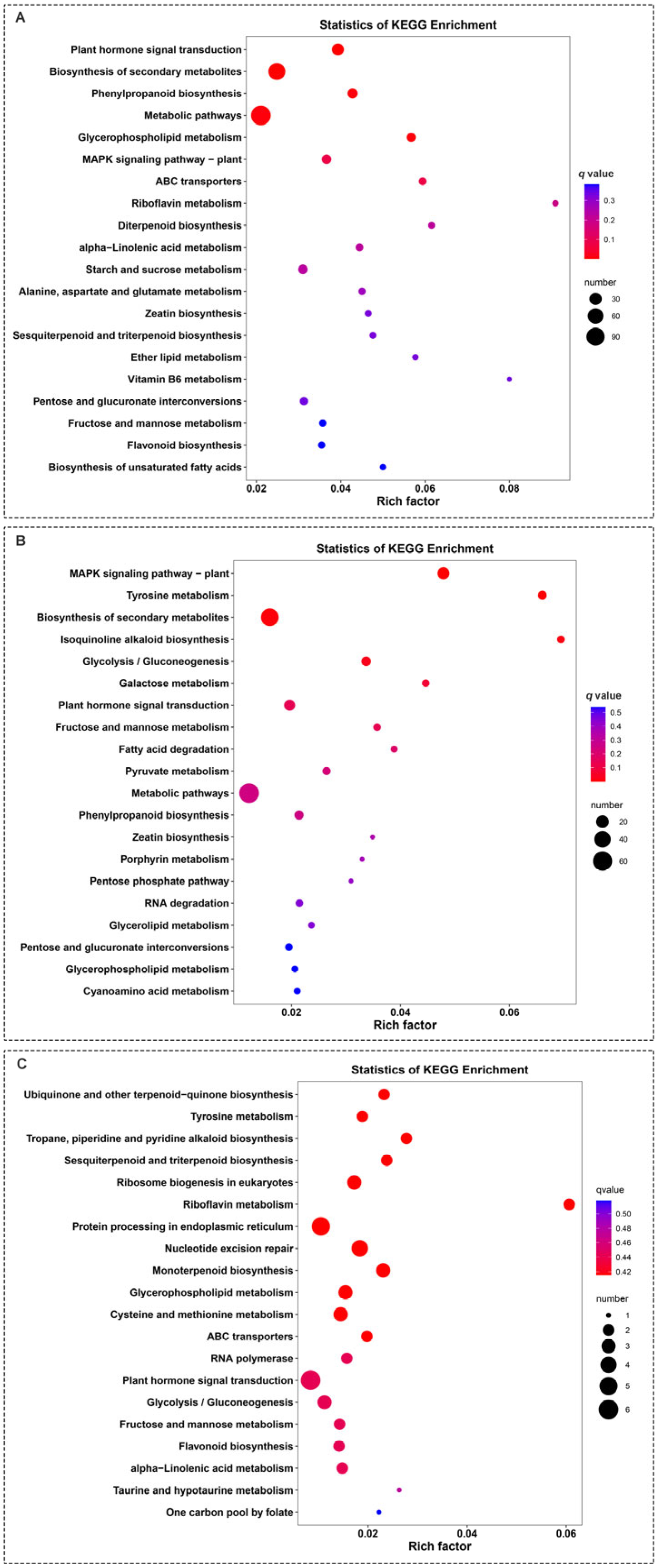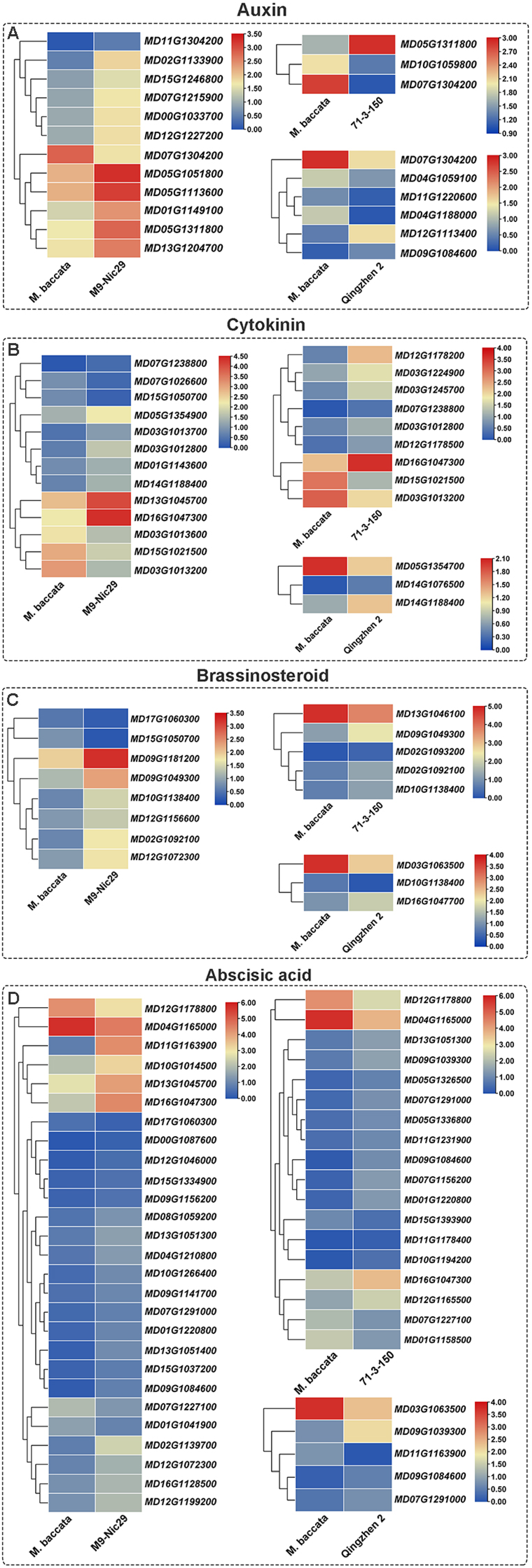1. Introduction
Apple (
Malus domestica Borkh.) is one of the most predominant fruit crops in the world, with the fruit providing nutritional and healthcare benefits [
1]. According to the data in FAOSTAT and National Bureau of Statistics of China, China is the world’s largest apple production and consumption country, with a yield of 49.60 million tons in 2023 [
2,
3]. Apple production relies heavily on grafting, combining well-adapted rootstocks with high-quality scions [
4]. The main aim of grafting is to reduce vegetative growth and shorten the juvenile growth period [
4,
5]. Rootstocks play crucial roles in various aspects of scion development, including bud outgrowth [
6], lateral branch induction [
7], fruit quality [
8], nutrient assimilation [
9,
10], and adaptation to unfavorable environmental conditions [
11,
12]. Rootstocks affect scion architecture, especially lateral branch development and height, which decides the planting and management mode used in orchards [
13]. Li et al. [
14] showed that dwarfing interstocks significantly reduce the height and diameter of ‘Gala’ apple trees, with little effect on the growth of annual branches. ‘Royal Gala’ scions grafted onto ‘Royal Gala’ self-rooted stocks produce numerous vigorous primary and secondary scion shoots, whereas the same scions grafted onto ‘M9’ dwarfing rootstocks generate fewer lateral branches [
15]. Chen et al. [
16] reported that ‘Fuji’ apple trees grafted onto ‘
Malus baccata’ have larger and more numerous branches than ‘Fuji’/‘M9-T337’/‘
M. baccata’ and ‘Fuji’/‘M9-T337’. Dwarfing rootstocks have previously been shown to limit scion growth by impeding the transport of nutrients, hormones, water, and mineral salts [
5,
17].
Although scion architecture is known to be affected by the rootstock, the molecular mechanisms underlying these effects are poorly understood. With the continuous development of genomics-based technologies, researchers have found that rootstocks regulate the growth of grafted trees by influencing gene expression patterns in scions [
16,
18,
19]. Liu et al. [
20] reported that during grafting, there is a horizontal transfer of genetic material between rootstock and scion, resulting in a large number of differentially expressed specific genes at the graft-healing interface. Most of these genes, such as xylan endoglucosyltransferase/hydrolase genes
XTH19 and
XTH20, invloved in cell division and healing at the rootstock interface, rather than growth regulation. Hormonal signals can control rootstock-mediated vigor by modifying gene expression in the scion part [
21]. Montesinos et al. [
22] noted that differences in almond tree architecture correlated with the differential expression of genes involved in hormonal and molecular responses associated with regulating apical dominance, branch formation, plant growth, cell wall formation, and nitrogen assimilation in scion. Auxin is the main regulator of establishing apical dominance and inhibiting bud outgrowth, it is synthesized in apical leaves and transported through the axis [
22]. Zhang et al. reported that transcription factor gene
NF-YA10 expression in shoot tips may be part of a regulation process in the formation of branches promoting cell growth via auxin-signaling regulatory pathway [
23]. Genetic changes in the biosynthesis or signaling pathways of various hormones such as zeatin riboside, brassinosteroid (BR), gibberellin (GA), abscisic acid (ABA) and jasmonic acid in scion leaves have caused a substantial impact on plant vigor and branch spreading [
24]. GA-related genes are involved in regulating dwarfing traits in mango, apple and peach [
15,
25,
26]. Apple scions with dwarfing rootstocks exhibit higher ABA levels, lower ratios of ABA to indole-3-acetic acid, and lower GA than vigorous rootstocks [
27]. The transport of BR from lateral branches to the stem is crucial to lateral bud development in pear trees [
18]. Xing et al. [
28] reported that the leaves of scion adjacent to the top buds of spurs play a significant role in bud development and branch growth by adjusting sugar content, nitrogen (N) content, carbon (C)/N ratios, sugar metabolism-related enzyme activities and hormone contents. Moreover, Chen et al. [
16] suggested that the most direct choice is to analyze leaf growth status to analyze the mechanism of rootstock-induced dwarfing, as the photosynthetic organ, the metabolism of leaves reflects the effects of grafting on tree branch architecture growth. Therefore, the analysis of the differences in gene expression patterns in leaves of ‘Harlikar’ with different rootstocks was more beneficial to revealing the mechanism of rootstock-mediated vigor by modifying gene expression in the scion part.
‘Harlikar’ is an excellent apple variety selected by Professor Kiyoshi Yokota from the natural hybrid offspring of ‘Golden Crown’ at Iwate University’s Department of Agriculture [
29]. It has rapidly become one of the main varieties grown in China. Selecting suitable rootstock is the key to achieving good quality and high output for fruit trees [
30]. Due to extensive planting and relatively poor orchard conditions in China, dwarfism and adaptability are the main criteria for selecting rootstocks [
31]. Moreover, cultivating trees with more lateral branches and larger opening angles, architecture suitable for light capture and mechanized cropping, is particularly critical. The breeding of apple dwarfing rootstock has progressed world-wide and include the M, MAC and CG, O3, B, P, JM, Qingzhen and SH series [
31]. However, rootstock/scion compatibility varies to the extent that even closely related species might not be compatible [
32]. Therefore, it is necessary to select suitable rootstocks for cultivated varieties. In this study, we grafted ‘Harlikar’ onto eight rootstocks and observed the effects of the rootstocks on parameters related to tree architecture, such as plant height, branch number, internode length, leaf photosynthetic capacity, and N/P/K content. Among the eight rootstock/scion combinations, branching formation and plant height, characteristics that affect fruit cultivation, were the traits that differed most. To analyze the molecular mechanisms that underlie the modification of scion architecture by rootstocks, we used RNA sequencing to analyze gene expression patterns in leaves of ‘Harlikar’ grafted onto different dwarfing rootstocks. The findings will aid the selection and utilization of apple dwarfing rootstocks in the future and increase our understanding of the mechanisms influencing shoot growth and development in grafted trees.
3. Discussion
Although grafting is widely used in apple production, some common rootstocks still exhibit graft incompatibility in orchards as scion varieties are updated and iterated [
32]. The rational use of rootstocks can improve tree structure, enhance stress resistance, regulate the production period, and improve fruit quality [
33]. Kumar et al. [
34] reported that the growth vigor of trees grafted onto ‘EMLA111’ and ‘EMLA7’ was larger than those on ‘BUD9’. Li et al. [
30] found that ‘Mac9’, as a dwarfing interstock, could significantly reduce the height and diameters of ‘Gala’/‘
M. baccata’ apple trees, while having few effects on the growth of annual branches. Chen et al. [
16] reported that ‘Fuji’ apple trees grafted onto ‘
M. baccata’ presented a larger branch architecture than ‘Fuji’/‘M9-T337’ and ‘Fuji’/‘M9-T337’/‘
M. baccata’. Lordan et al. [
35] found ‘Honeycrisp’/‘B72020’ was the stock with more upright branches, while ‘Honeycrisp’/‘B10’ and ‘Honeycrisp’/‘G11’ had the flattest. ‘
M. baccata’ is a traditional vigorous rootstock widely used in China [
36]. Nowadays, dwarfism is one of main objectives for rootstock selecting and breeding [
31].
To select suitable dwarfing rootstocks for ‘Harlikar’, a widely cultivated apple variety in China in recent years, we grafted ‘Harlikar’ scions onto seven dwarfing rootstocks (
Figure 2). ‘M9’ is the most commonly used dwarfing rootstock in the world because of its suitability for high-density plantings [
37], and many excellent lines selected from ‘M9’ as well as its hybrid posterity, such as ‘M9-T337’, ‘M9-Nic29’, and ‘M9-Pajam 2’ and ‘M26’ have been widely used for crop production in some countries and regions [
38]. ‘M9-T337’ confers early fruiting and high yields [
39]. The rooting and branching abilities of ‘M9-Nic29’ were better than ‘M9’ [
40]. ‘M9-Pajam 2’ is the most vigorous subclone of ‘M9’, from a range of tested types, and it also has better rooting and branching abilities than ‘M9’ [
40,
41,
42]. Gjamovski et al. [
41] reported that ‘M9-T337’ with less vigorous was suitable for high-density apple orchards, while ‘M9-Pajam 2’ was recommended for less vigorous apple cultivars and rare apple plantations. The semi-dwarfing rootstock ‘M26’ shows good stationarity and grafting affinity, and has stronger cold resistance compared with ‘M7’, ‘JM7’, ‘M9-T337’ and ‘M9’ [
43]. ‘B9’ can offer several advantages, including strong tree architecture, uniform in fruiting, best in quality, and resistance to pests, diseases, and cold [
44], and it is shown to be more dwarfing than M9 series [
45]. According to the research of Yin et al. [
46], the semi-lethal temperature of ‘71-3-150’ reached −40.63 °C, its cold resistance was better than ‘GM256’ and ‘M9’. ‘Qingzhen 2’ is semi-dwarfing apomixis rootstock with a large open branching angle, deep root distribution and wide-ranging adaptability, and suitable for most small-scale orchards in China with poor soil conditions [
47]. In this study, among eight apple scion/rootstock combinations used in this study, the highest survival rate of scions were observed in ‘Harlikar’/‘Qingzhen 2’ (
Figure 1), however, its dwarfism was not prominent (
Figure 3). Besides, the survival rate of ‘Harlikar’ grafted onto M series such as ‘M9-T337’, ‘M9-Nic29’ and ‘M9-Pajam2’ was higher than that of ‘Harlikar’ grafted onto ‘
M. baccata’. And the affinity of ‘Harlikar’ with cold-resistant apple dwarfing rootstocks ‘B9’ and ‘71-3-150’ was superior to that of ‘Harlikar’ with ‘
M. baccata’. The above-ground material accumulation in the ‘Harlikar’/‘B9’, ‘Harlikar’/‘M9-T337’, ‘Harlikar’/‘M9-Nic29’, ‘Harlikar’/‘M9-Pajam2’ and ‘Harlikar’/‘71-3-150’ combinations was lower than in ‘Harlikar’/‘
M. baccata’ (
Figure 3E). And the above five rootstocks could be used as candidate dwarfing rootstocks for ‘Harlikar’, ‘71-3-150’ could be prioritized in north China, where the climate is cold and dry in winter [
48].
Our results showed that ‘Harlikar’ was less compatible with ‘M26’ (
Table A1). Graft compatibility/incompatibility is a complex response that includes a wide range of anatomical, physiological, and biochemical interactions. Successful grafting begins with an initial wound. Tissues from the scion cultivar are fused with the rootstock to form one composite organism [
49]. At the graft interface of ‘Harlikar’/‘M26’, there was less callus formed (
Figure A1E). Even though the leaf buds of scions sprouted in the early stage of grafting, the survival rate was lower than that of the other seven scion/rootstock combinations over time (
Figure 1). Foliage etiolation is an observed symptom of graft incompatibility [
32]. For example, ‘Hongmian miyou’ is mutated from ‘Guanxi miyou’, but these two scions show different compatibility with available ‘
Poncirus trifoliata’ rootstock, and phloem collapse with cell wall distortion and thickening in the prominent midribs, as well as foliage etiolation were much more frequently observed in ‘Hongmian miyou’/‘
P. trifoliata’ [
32]. Chen et al. [
49] reported that a compatible combination had higher chlorophyll content and net photosynthetic rate than an incompatible combination in litchi. Consistent with the results from the present study, the
Pn,
Gs,
Tr, and SPAD of ‘Harlikar’ grafted onto ‘M26’ was lowest (
Figure 4A,B,D,E), and foliage etiolation was obvious (
Figure 2E). The SPAD index values indicated restricted carbohydrate assimilation and N uptake due to translocated incompatibility [
5]. Therefore, ‘M26’ is not suitable for ‘Harlikar’ in north China.
Apart from ‘Harlikar’/‘M26’, the height of ‘Harlikar’ grafted onto ‘71-3-150’ was lowest in this study (
Figure 3). Differently, ‘Harlikar’/‘71-3-150’ had the highest leaf SPAD values among the eight apple scion/rootstock combinations (
Figure 4E,
Table A3), and foliage etiolation was not observed in the leaves of scions (
Figure 2). Thus, ‘71-3-150’ may post positive effects on the dwarfing of ‘Harlikar’, the molecular biology of the dwarfing mechanism should be further clarified. Additionally, we found that the number of lateral branches in ‘Harlikar’/‘Qingzhen 2’ was higher than that in the other seven scion/rootstock combinations (
Table A1), and the branch opening angle in ‘Harlikar’/‘Qingzhen 2’ was close to 90 degrees (
Figure 2G). Therefore, ‘Qingzhen 2’ had remarkable effects on the tree architecture of ‘Harlikar’, and the mechanism needs to be further investigated.
The key to rootstock-scion interaction is recognition and information flow between the rootstock and scion cells. Phloem tubes contain hundreds of types of RNA, including short RNAs, noncoding RNAs and mRNAs. These RNAs can affect various aspects of plant growth, such as leaf development, fruit quality, and root formation [
30]. Therefore, we hope to screen key genes regulating dwarfing traits, and branching architecture in apple using transcriptome technology. Tree vigor is mainly controlled by hormone responses and nutrient availability [
22]. Hormonal regulation has been proposed as an important mechanism through which rootstocks influence scion morphology by changing shoot-root chemical signaling [
24]. Li et al. [
14] suggested that the oxidation or degradation of auxin in the phloem may lead to dwarfing of apple rootstocks. In this study, auxin-repressed protein gene
ARP (
MD05G1311800) was up-regulated in ‘Harlikar’/‘71-3-150’ and ‘Harlikar’/‘M9-Nic29’ (
Figure 9A). It was closely related to the dwarfing trait of ‘Harlikar’/‘71-3-150’ and ‘Harlikar’/‘M9-Nic29’. The levels of endogenous CKs in plants are regulated by isopentenyl transferases (IPT), cytochrome P450 monooxygenase (family 735, subfamily A), CK oxidase/dehydrogenase (CKX) and other biosynthetic and degrading enzymes. The tZ-type CKs are biosynthesized via CYP735A and have a specific function in shoot growth promotion [
50]. Kiba et al. [
51] demonstrated that
CYP735A3 and
CYP735A4 encode cytochrome P450 monooxygenase (P450), required for tZ-type side-chain modification in rice, which function in promoting shoot and root growth. tZ-type CK biosynthesis is negatively regulated by auxin, ABA, and CK, and positively regulated by dual N nutrient signals, namely glutamine-related and nitrate-specific signals. In this study,
CKXs were down-regulated in ‘Harlikar’/‘M9-Nic29’ and ‘Harlikar’/‘71-3-150’, and
CYP735A was down-regulated in ‘Harlikar’/‘M9-Nic29’ (
Figure 9B). The down-regulation of these genes may lead to decreased CK contents, which are associated with lower plant height in the two rootstock/scion combinations. Sun et al. [
52] isolated
ZmCYP90D1, which encodes a member of the cytochrome P450 family, from a spontaneous dwarfing mutation of maize,
m30, with decreased internode number and length but increased internode diameter.
ZmCYP90D1 could influence plant height and stalk diameter via hormone-mediated cell division and cell growth via the BR pathway. The differences in height among ‘Harlikar’/‘M9-Nic29’, ‘Harlikar’/‘71-3-150’, and ‘Harlikar’/‘Qingzhen 2’ may be due to the transcription levels of
CYP87A3 and
CYP92A6, which involved in BR biosynthesis in apple (
Figure 9C). In addition, studies have shown that plant height is closely related to the synthesis of GAs. Zhang et al. [
25] noted the up-regulation of the gibberellin 3β-hydroxylase gene
GA3ox and the accumulation of GAs in dwarfed mangoes, while Hooijdonk et al. [
15] suggested that disrupting GA metabolism plays a vital role in dwarfing the scion. Li et al. [
30] found that auxin and GA were inhibited, and abscisic acid was promoted in apple trees when using dwarfing interstocks for grafting [
5]. BR promotes plant cell elongation through a complex signaling cascade that modulates the activities of growth-related genes and through interaction with GAs [
53,
54]. In addition, multiple GA-responsive genes, such as
GASAs (
MD15G1246100,
MD08G1088900,
MD14G1081900, and
MD02G1132400) and
LOB (
MD09G1088700), were down-regulated (
Figure A4A). Hayat et al. [
24] reported high expression of
GID1, a GA receptor gene, in the leaves of dwarfing rootstock, suggesting that it might reduce the biological activity of GA. Consistent results were also found in this study.
GID1 (
MD12G1227200) was markedly down-regulated in ‘Harlikar’/‘Qingzhen 2’ leaves but up-regulated in ‘Harlikar’/‘M9-Nic29’ leaves (
Figure A4A). Phenotypically, ‘Harlikar’/‘M9-Nic29’ displayed obvious dwarfing characteristics compared with ‘Harlikar’/‘Qingzhen 2’. The interaction of BR and GA at the signaling and metabolic levels has been confirmed to influence cell elongation and plant height control in rice and Arabidopsis [
53]. Therefore, it can be inferred that BR-GA interaction affected plant height in different apple rootstock/scion combinations. Furthermore, the abscisic-aldehyde oxidase gene
AAO3 (
MD11G1178400), the gene for an enzyme that catalyzes the final steps of ABA synthesis (9-cis-epoxycarotenoid dioxygenase)
NCED (
MD10G1194200), and multiple ABA-response-related genes were significantly up-regulated. These DEGs were closely related to the dwarfing trait of ‘Harlikar’/‘71-3-150’ (
Figure 9D).
Phytohormones are known to influence branching. CKs promote shoot branching by activating axillary buds. There is a strong specialization involving the ARR-independent mechanism of CK signaling that controls shoot branching, in which type-A ARR proteins are negative regulators of transcriptional CK signaling (type-A mutants exhibit reduced bud activation), whereas type-B ARR proteins positively regulate CK-induced gene expression [
55]. In this study, ARR-A family member
MD14G1188400 was up-regulated in ‘Harlikar’/‘Qingzhen 2’ (
Figure 9C), and it may be one of the reasons for the higher number of lateral branches in ‘Harlikar’/‘Qingzhen 2’ (
Figure 2 and
Figure 3C,
Table A1). Eduardo et al. [
56] reported that TCP transcription factor BRANCHED1 (BRC1) binds to and positively regulates the transcription of three related Homeodomain leucine zipper protein-encoding genes, enhancing
NCED3 expression and promoting ABA accumulation, thereby suppressing bud development. Moreover, ABA-responsive binding factors (ABF) was induced by ABA [
57]. Zhu et al. [
58] found that GA positively regulates the branching angle of tea plants, the cytokinin metabolism genes
CKX and the abscisic acid signal transduction gene
PYL4 were involved in the formation of branching angles in tea plants. Consistent results were found in this study, as the ABA-responsive element binding factor gene
ABF (
MD11G1163900) was down-regulated in ‘Harlikar’/‘Qingzhen 2’, while it was significantly up-regulated in ‘Harlikar’/‘M9-Nic29’. In addition,
NCED1 (
MD10G1194200) and
AAO3 (
MD11G1178400) were up-regulated in ‘Harlikar’/‘71-3-150’ (
Figure 9D). The down-regulation of
ABF may be the another key reason to increased branching in ‘Harlikar’/‘Qingzhen 2’ (
Figure 2G,
Table A1). Furthermore, it this study,
CKX (
MD15G1021500) and
PYL4 (
MD07G1227100,
MD12G1178800, and
MD04G1165000) were down-regulated in ‘Harlikar’/‘M9-Nic29’ and ‘Harlikar’/‘71-3-150’, but not down-regulated expressed in ‘Harlikar’/‘Qingzhen 2’ compared with ‘Harlikar’/‘
M. baccata’ (
Figure 9B,D). These genes may be closely related to the branching angle formation in apple.
We also noted that, although there was no difference in total N accumulation between the roots of ‘
M. baccata’ and ‘Qingzhen 2’, the total N accumulation in leaves and stems of ‘Harlikar’ grafted onto ‘Qingzhen 2’ was significantly higher than that of the scion grafted onto ‘
M. baccata’ (
Figure 5A,
Table A4). Moreover, the total P and K accumulation in the roots of ‘Harlikar’/‘
M. baccata’ was higher than in ‘Harlikar’/‘Qingzhen 2’, but that in the leaves and stems of scions grafted onto ‘
M. baccata’ was significantly lower than in ‘Harlikar’/‘Qingzhen 2’ (
Figure 5A,
Table A5 and
Table A6). Furthermore, ‘Harlikar’/‘Qingzhen 2’ grew taller than ‘Harlikar’/‘
M. baccata’ (
Figure 3A). We speculate that there were some DEGs related to nutrient utilization between ‘Harlikar’/‘Qingzhen 2’ and ‘Harlikar’/‘
M. baccata’, which affected the growth of scions. The availability of nutrients, particularly N and P, is crucial for plant development, and grafting affects the movement of these substances through the xylem [
59]. The DEGs screened from three scion/rootstock combinations were enriched in cellular acid phosphatase activity (GO:0004674) (
Figure A2). Liu et al. [
60] found that acid phosphatase (coded for by
ACP2) primarily catalyzed the hydrolysis of phosphorethanolamine and phospho-L-serine, and elevated serine levels reduced the expression of genes involved in the photorespiratory pathway of an
ACP2-overexpression line. Our findings revealed the down-regulation of several acid phosphatase genes
ACPs (
MD13G1016100,
MD12G1023300, and
MD14G1240300) and serine/threonine-protein kinase genes
PBLs (
MD05G1010000,
MD05G1220200, and
MD10G1008700) in ‘Harlikar’/‘Qingzhen 2’. In contrast, these genes were all up-regulated in ‘Harlikar’/‘M9-Nic29’ (
Figure A5 and
Figure A6). The up-regulation of
ACPs and serine/threonine-protein kinase genes in ‘Harlikar’/‘M9-Nic29’ may inhibit photosynthesis, hindering the vegetative growth of scions. On the contrary, the
Pn of leaves in ‘Harlikar’/‘Qingzhen 2’ significantly increased, thus enhancing the aboveground growth (
Figure 3A and
Figure 4A). Compared with ‘Harlikar’/‘
M. baccata’, the potassium channel protein gene (
MD02G1037900)
AKT1 and multiple receptor-like protein genes such as
EIX1s (MD01G1062000, MD01G1062500) and
EIX2 (MD01G1061600) were significantly up-regulated in the leaves of ‘Harlikar’/‘M9-Nic29’ and ‘Harlikar’/‘71-3-150’, and the potassium transporter gene
HAK1 (
MD11G1069200) was up-regulated in the leaves of ‘Harlikar’/‘M9-Nic29’ (
Figure A7). Therefore, the total K contents in the above-ground parts of ‘Harlikar’/‘M9-Nic29’ and ‘Harlikar’/‘71-3-150’ were significantly higher than in ‘Harlikar’/‘
M. baccata’ (
Figure 5C). Compared with ‘Harlikar’/‘
M. baccata’, the aquaporin gene
MD01G1121900 (
TIP1) was significantly up-regulated in the leaves of ‘Harlikar’/‘Qingzhen 2’ (
Figure A5). Water-N coupling positively affects the yield, quality, water- and N-use efficiencies of crops [
61]. The up-regulation of
TIP1 may, therefore, improve the absorption of water and nutrients in ‘Harlikar’/‘Qingzhen 2’. In brief, multiple genes related to hormone signaling and nutrient utilization were involved in the regulation process of rootstock on the growth, development, and formation of lateral branches of apple scion.
